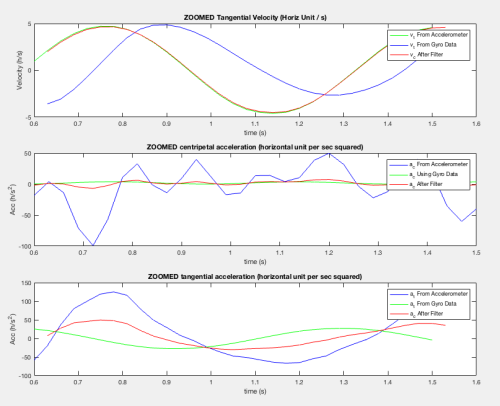This is an old revision of the document!
For Node a1
Node a1 is the node that is undergoing circular motion. With no oscillation, the angular displacement of node a1 will be increasing as shown in the first graph in the figure below.
Because a1 is going in circular motion, with the motor at a constant speed, the angular velocity should also be at constant speed (roughly 9 rad/s = 89 RPM), as shown by the angular velocity graph, where the deviations are when the motor is reaching steady state when it turns on and when it turns off.
With constant angular velocity, angular acceleration should be zero, as shown by the third graph in the figure below.

The tangential velocity, tangential acceleration, and centripetal acceleration data are shown to let the user understand which set of data is more dominant after the complementary filter.

The zoomed in version for the angular data is shown.

The zoomed in version for the linear data is shown.

Using the data filtered through the complementary filter, the velocity and the acceleration in x and in y directions are graphed and shown below.

For Node b1
Node b1 oscillates as the crank moves. As shown by the angular displacement graph, the angular displacement of node b1 comes in cycles, where the maximum displacement is roughtly -15 degrees (which is 15 degrees counterclockwise).
Both the angular velocity and angular acceleration oscillates as well as the bar changes direction of rotation.

The tangential velocity, tangential acceleration, and centripetal acceleration data are shown where the gyroscope data dominates in all three graphs. This limits the noise caused by the accelerometer data.

The zoomed in version for the angular data is shown.

The zoomed in version for the linear data is shown.

Using the data filtered through the complementary filter, the velocity and the acceleration in x and in y directions are graphed and shown below.

Causes for Error
Hardware wise, the errors are caused by the oscillation of the sensors when the 4 bar linkage is moving to obtain data. The frictions in the pins will also prevent the experimental results to deviate from the theoretical results from MATLAB, where MATLAB is based purely on kinematics (which doesn't consider forces, or how things started to move).
Software wise, the errors are from the error propagation in rounding and smoothing of the data from the sensor. The sensor themselves have a lot of noise (especially accelerometer) and the gyroscope sensor is known to drift. Although all of these problems was corrected to a certain extend in the MATLAB code when I processed the data. But without prior knowledge on data processing, the filters are definitely not perfect.
